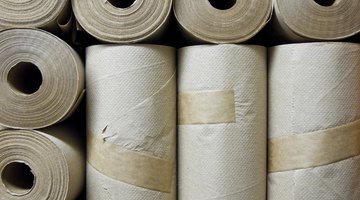Information and Facts About Paper Towels
Table of Contents
The EcoConsumer Waste Calculator provided by King County, Wash., allows you to measure the environmental impact of your paper towel use. It helps you understand how everyday consumption of paper products affects the volume of the municipal waste stream.

If each Washington resident used just one paper towel per day, the state would generate 134,312 tons of waste per year.
Manufacturing
Paper towels and paper are made from the same kinds of plant fibers, according to the Internships in Public Science Education program at Penn State University. Paper fibers used to manufacture paper towels “are mixed with a special type of resin to make them strong when they are wet.” This resin prevents paper towels from tearing easily when wet.
Quilting
Paper towels are known for their absorbency. Information furnished by the IPSE explains that quilting is part of what makes this possible. After the paper fibers mixed with resin are made into sheets, shapes are pressed into them that impart a quilted appearance. The quilted shapes form pockets of air that attract water and increase absorbency.
Types
There are two types of paper towels: folded and rolled. Folded paper towels come with a bifold or a multifold. Conservatree says, “People use more folded towels than roll varieties.” It explains that people pull multiple folded towels out of the dispenser, while a dispenser for rolled towels gives out one at a time. Conservatree reports that switching to rolled towels may reduce waste between 25 percent and 30 percent.
The process used to manufacture the towels also divides this paper product into different types. White paper towels are bleached using chemicals or a natural process, depending on the brand. Paper towels with a light brown color are semibleached or unbleached.
Cost
According to a five-year cost analysis performed by the Office of Sustainability at Lane Community College, an electric hand dryer is more cost efficient than paper towels. The comparison was performed using the basis of 200 units--hand dryers and paper towel dispensers. The study factored in cost of materials, disposal and labor, seconds of dry time and electricity along with purchase and installation cost. The cost of a hand dryer was $150,343, while the cost for paper towels was $524,183.
Sprouting
The Michigan Department of Agriculture suggests using the paper towels in your kitchen to do more than clean up spills. Use your paper towels the next time you want to sprout seeds. Fold any paper towel in quarters, put it on a plate and moisten it so it’s completely wet but not sitting in a puddle of water. Open the last fold of the paper towel and place your seeds on one half. Leave space between the seeds so they can sprout unobstructed and fold the paper towel again. Keep it moist by spraying it with water. The time it takes for the seeds to sprout depends on the type of seeds.
References
Writer Bio
Victoria Weinblatt began writing articles in 2007, contributing to The Huffington Post and other websites. She is a certified yoga instructor, group fitness instructor and massage therapist. Weinblatt received her B.S. in natural resources from Michigan State University and an M.Ed. from Shenandoah University.
Photo Credits
- ian macdonald/iStock/Getty Images
- ian macdonald/iStock/Getty Images
More Articles



